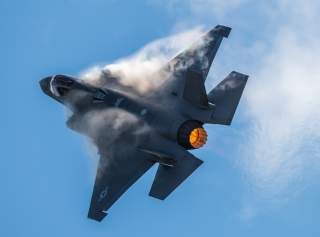America Wants Its Robot Warrior XQ-58A Valkyrie To Fight Alongside The F-35
Drones will improve pilots' ability to locate targets.
Key point: Wingman drones could change the way major air forces fight.
The U.S. Air Force could be months away from deciding whether to put into production its first, fighter-style “wingman drone.”
But California unmanned aerial vehicle-maker Kratos, builder of the Air Force’s prototype XQ-58A Valkyrie wingman UAV, is confident the flying branch will decide to proceed.
Kratos has begun placing engine orders in anticipation of receiving first series production contracts for the XQ-58, Jane’s reported.
“Reporting the company’s second-quarter 2019 results in a [July 31, 2019] earnings call, Kratos president and CEO Eric DeMarco said that the company was confident that Valkyrie was “on track for initial production and a programme of record,” according to Jane’s.
The company has begun ordering engines “for expected Valkyrie production to meet anticipated future customer delivery requirements,” DeMarco said.
“The XQ-58A demonstrator is powered by an off-the-shelf Williams International FJ33 twin-spool turbofan,” Jane’s noted. “It has not been confirmed if this engine type is being retained for follow-on production.”
The Air Force’s wingman drone initiative is moving quickly. The Air Force Research Laboratory’s Skyborg program is developing artificial intelligence for the wider wingman-drone effort. To develop the hardware, AFRL is experimenting with copies of the subsonic XQ-58.
The Air Force wants an early version of a wingman drone to be ready for combat by 2023. Kratos is betting that the service will tap the XQ-58 as the basis for a combat-ready wingman ‘bot.
The Valkyrie’s first flight took place in March 2019. The 29-feet-long, jet-powered XQ-58 on June 11, 2019 took off for its second test flight over Yuma, Arizona. The Air Force and Kratos plan to conduct five test sorties during this phase of the XQ-58’s development.
The Air Force also has begun testing software that could help its future robot wingmen pull hard maneuvers in aerial combat.
The initial software test took place at Edwards Air Force Base in California on July 25, 2019. The Air Force’s 412th Test Wing’s Emerging Technologies Combined Test Force installed new flight-control software on a small, radio-controlled drone.
“What we have here today is a sub-scaled jet-powered aircraft; it’s about 12 feet long and do about 250 knots,” stated Jeff Jessen, an engineer with the Emerging Technology Combined Test Force. “Our goal is to verify an autonomy safety net.”
The Testing Autonomy in a Complex Environment software, or TACE, is a product of the Applied Physics Lab at Johns Hopkins University.
A new version of the Air Force’s F-35A stealth fighter, as well as the heavily upgraded version of the F-15 that the flying branch hopes to acquire, both could function as flight leads for the service’s wingman drones, Will Roper, the Air Force’s top weapons-buyer, told Defense News reporter Valerie Insinna.
The Air Force is in discussions with Boeing and Lockheed respectively to modify their F-15EX and F-35A Block 4 fighters to accommodate the datalinks and processors from the Skyborg effort, Insinna reported.
Roper told Insinna that pairing manned fighters with drones could “open up the door for an entirely different way to do aerial combat.”
“For example, take a typical four-aircraft formation and replace it with an F-15EX and three Valkyries,” Insinna explained.
“We can take risk with some systems to keep others safer,” Roper said. “We can separate the sensor and the shooter. Right now they’re collocated on a single platform with a person in it. In the future, we can separate them out, put sensors ahead of shooters, put our manned systems behind the unmanned. There’s a whole playbook.”
Boeing's Australian subsidiary in February 2019 unveiled its so-called "Airpower Teaming System," a 38-foot-long, jet-powered drone that the company said could carry weapons and sensors and fly as far as 2,000 miles—all while being more affordable than a $100-million manned jet.
Boeing developed the new drone in cooperation with the Australian military. After further development, the Royal Australian Air Force could acquire the UAV to quickly and cheaply add firepower to its roughly 100-strong fighter fleet and six E-7 radar planes.
"The Boeing Airpower Teaming System is designed to team with a wide range of existing military aircraft from fighters to commercial derivative aircraft," said Ashlee Erwin, a Boeing spokesperson.
Beside Australia, China and Japan also are working on wingman drones. A mock-up or prototype of China's 30-feet-long Dark Sword drone first appeared in public in an undated photo that circulated on-line in mid-2018.
Japan revealed its own "Combat Support Unmanned Aircraft" wingman drone concept in a technology roadmap that Aviation Week first published in late 2016.
Wingman drones could change the way major air forces fight, according to Peter W. Singer, author of Wired for War. "The idea of a robot wingman is that it can keep pace with manned planes, but be tasked out for parts of the mission that you wouldn't send a human teammate to do.”
David Axe serves as Defense Editor of the National Interest. He is the author of the graphic novels War Fix, War Is Boring and Machete Squad. This first appeared in August 2019.
Image: DVIDS.

